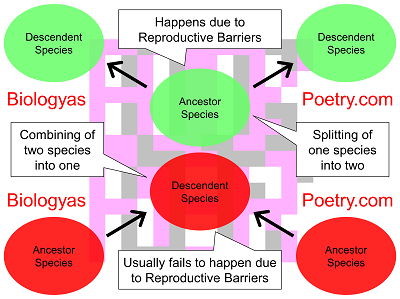Phenomena that have the effect of splitting single gene pools into more than one gene pool.
Reproductive isolation, a.k.a., presence of reproductive barriers, is crucial to the both the process of speciation and the definition of biological species (i.e., the biological species concept). It is the formation of reproductive barriers that in fact give rise to speciation events and reproductive isolation is similarly crucial to preventing species from regularly blending back together into hybrid populations.
Reproductive isolation is not necessarily absolute, which means that the term describes a concept that is more complicated than at first one might appreciate. The problem is that, even with reproductive isolation, gene flow may still occur between populations, that is, via processes described as introgression and/or horizontal gene transfer. By necessity, however, for two populations to remain reproductively isolated then gene flow – i.e., genetic migration – cannot be substantial.
Separate species are reproductively isolated from one another, though as noted this reproductive isolation is not necessarily absolute for similar species with overlapping ranges (i.e., sympatric species).
Subspecies are much less reproductively isolated populations versus separate species, though with some reproductive isolation between distinct subspecies still present. Within a single subspecies, that is, there are much fewer barriers to gene flow versus between members of different species. Peripheral isolates are reproductively isolated at least as equivalent to the reproductive isolation seen between subspecies, if not more so.

There thus exists a continuum or reproductive isolation. At one extreme is a group of organisms consisting of a single gene pool, indeed in which nonrandom mating occurs (panmixis). At the other extreme, a group of organisms can consist of two populations between which no gene flow occurs. Reproductive isolation describes a state that is much closer to this second scenario than the first.